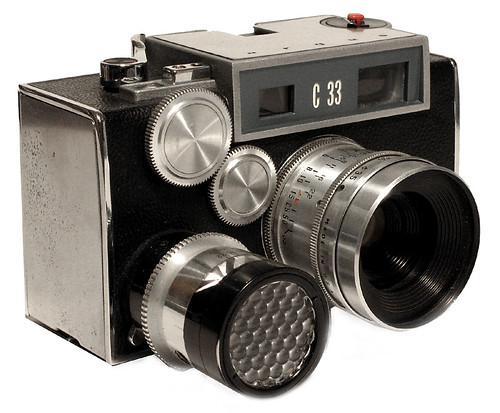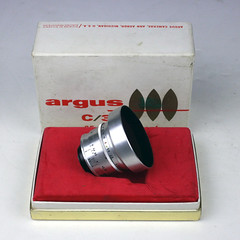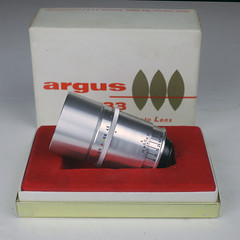Difference between revisions of "Argus C33"
m (in article links, misc) |
|||
| Line 13: | Line 13: | ||
When compared to competing Japanese cameras then being brought to market, it is hard to avoid the conclusion that Argus had badly lost its way by this time. The [[Argus Autronic I]] followed soon after, retaining a similar boxy styling but incorporating the meter and rangefinder coupling within the body. | When compared to competing Japanese cameras then being brought to market, it is hard to avoid the conclusion that Argus had badly lost its way by this time. The [[Argus Autronic I]] followed soon after, retaining a similar boxy styling but incorporating the meter and rangefinder coupling within the body. | ||
| + | |||
| + | == Lenses == | ||
The '''Argus C 33''' accepted two optional lenses that were made in Germany by [[Steinheil]], Munich (Munchen). A 35mm, f4.5 wide-angel Cintar and a 100mm, f4.5 telephoto Cintar. Both bayonet mount lenses coupled to the [[split image rangefinder]] and, having non-rotating barrels, the engraved distance numbers, depth of field scale and f-stops remained easily visible and upward facing while focusing. The two lenses were not compatible with any other Argus models. | The '''Argus C 33''' accepted two optional lenses that were made in Germany by [[Steinheil]], Munich (Munchen). A 35mm, f4.5 wide-angel Cintar and a 100mm, f4.5 telephoto Cintar. Both bayonet mount lenses coupled to the [[split image rangefinder]] and, having non-rotating barrels, the engraved distance numbers, depth of field scale and f-stops remained easily visible and upward facing while focusing. The two lenses were not compatible with any other Argus models. | ||
Revision as of 13:03, 10 October 2012

|
| Argus C33 image by Rick Soloway (Image rights) |
The C 33 was a very strange 1959 attempt by Argus to modernize the C3, with a combined rangefinder/viewfinder eyepiece and accepting a selenium meter which clipped to the shutter-speed dial.
When compared to competing Japanese cameras then being brought to market, it is hard to avoid the conclusion that Argus had badly lost its way by this time. The Argus Autronic I followed soon after, retaining a similar boxy styling but incorporating the meter and rangefinder coupling within the body.
Lenses
The Argus C 33 accepted two optional lenses that were made in Germany by Steinheil, Munich (Munchen). A 35mm, f4.5 wide-angel Cintar and a 100mm, f4.5 telephoto Cintar. Both bayonet mount lenses coupled to the split image rangefinder and, having non-rotating barrels, the engraved distance numbers, depth of field scale and f-stops remained easily visible and upward facing while focusing. The two lenses were not compatible with any other Argus models.
The wide-angle and telephoto lenses came with lens shades that matched the brushed aluminum finish of the lens barrels and screwed into the series VI front lens ring. Both lenses were of a four element design, coated and had click f-stops.

|
| Argus C 33 Wide-angle Steinheill Cintar 100mm f4.5 image by Frank Reiser (Image rights) |

|
| Argus C 33 Telephoto Steinheill Cintar 100mm f4.5 image by Frank Reiser (Image rights) |

|
| Argus C 33 Bayonet Mount with “Red Dot” alignment image by Frank Reiser (Image rights) |